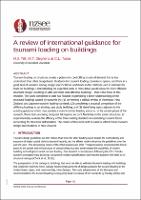| dc.description.abstract | Tsunami loading on structures creates a potentially controlling structural demand that is less understood than other design loads. Guidance for tsunami loading scenarios is sparce, and there is a great deal of variation in the methods used to estimate the loads on buildings in different design standards. Understanding the expected loads in more detail would allow for more efficient structural design, resulting in safer and more cost-effective buildings. The work completed to-date has focused on providing a better understanding of the structural loadings caused by tsunamis by: (1) performing a critical review of New Zealand, American, and Japanese tsunami loading standards, (2) completing a practical comparison of the differing loadings to an existing case study building, and (3) identifying topics adjacent to the existing guidance which may provide a more wholistic loading scenario. In the current phase of the research, flume tests are being designed, taking into account flexibility in the scaled structures, to experimentally evaluate the efficacy of the three loading standards in estimating tsunami forces accounting for structural deformation. The results of this work will be used to inform future tsunami design specifications in New Zealand. | |

